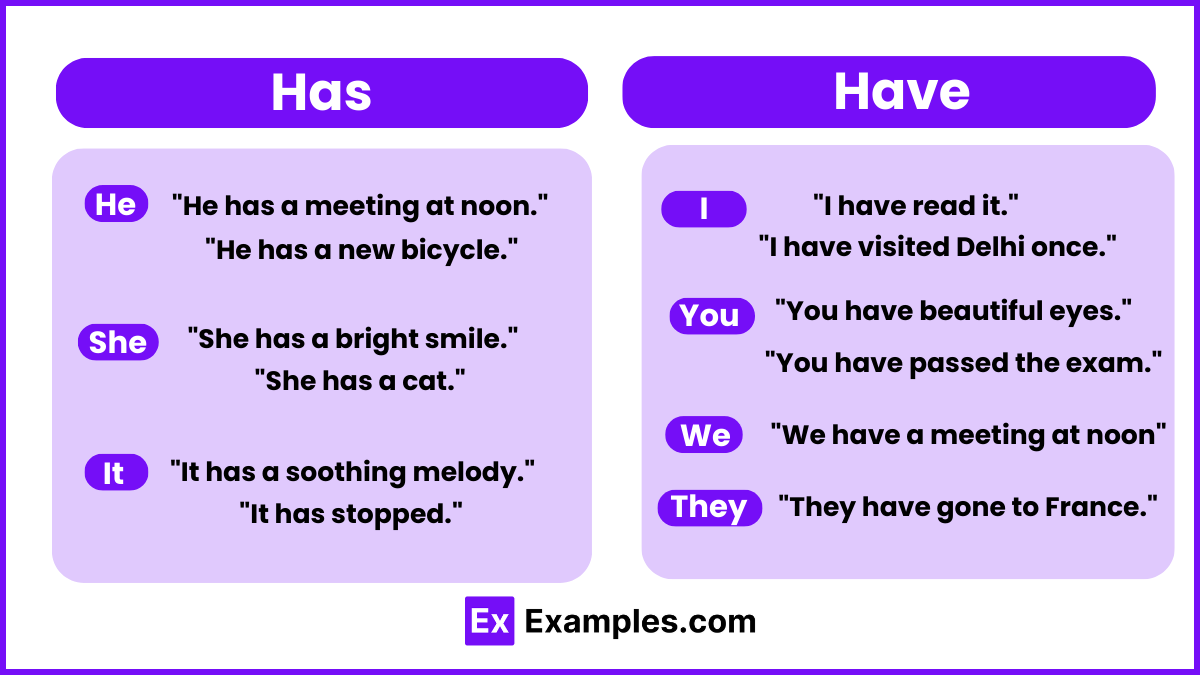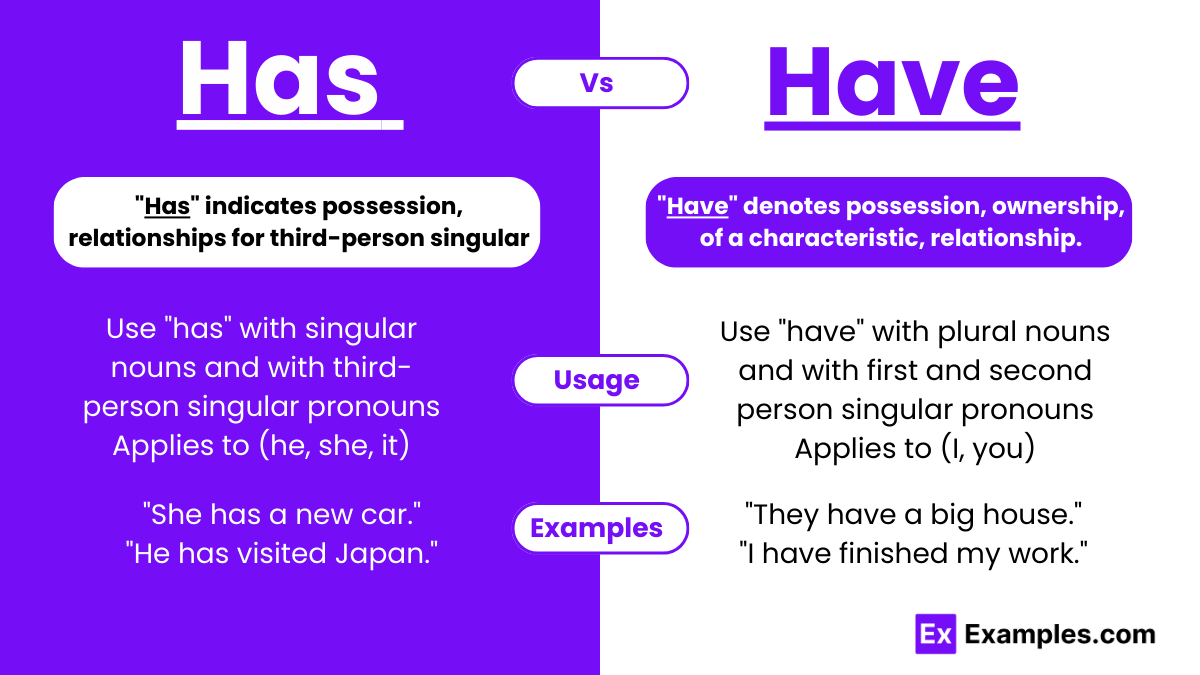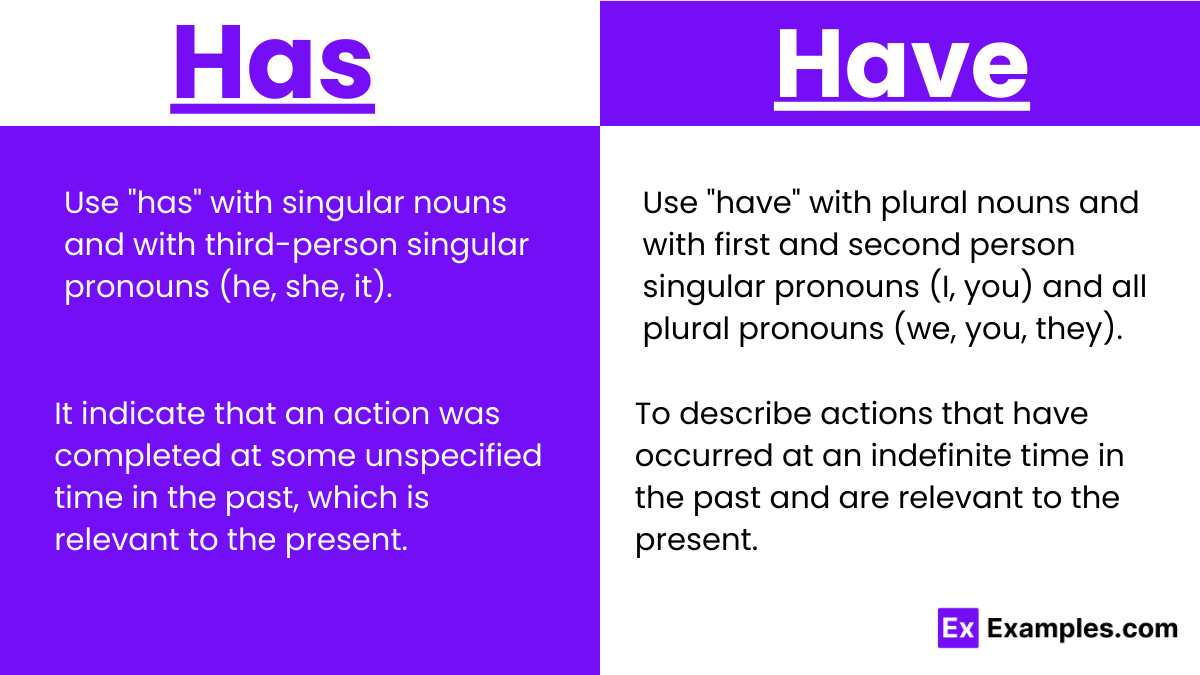Has vs Have – Examples, Differences, Usage
“Has” and “have” stand as pivotal words in the English lexicon, primarily denoting possession. Despite their frequent use in daily dialogue, the intricacies of their grammatical application often elude many.
These terms both derive from the verb “to have,” yet their usage diverges based on the grammatical subject. “Has” is appropriate for singular nouns and the pronouns “he,” “she,” and “it,” whereas “have” aligns with plural nouns and the pronouns “I,” “you,” “we,” and “they.” As an irregular verb, “to have” presents a unique challenge in conjugation, deviating from standard verb conjugation patterns, which adds a layer of complexity to its correct usage.
Has and Have – Meanings
“Has” and “Have” are both forms of the verb “to have,” which is a fundamental verb in English used to indicate possession, relationships, or various states of being. Here’s a closer look at their meanings and applications:
Has:
- Singular Use: “Has” is used with third-person singular subjects (he, she, it, or any singular noun). It denotes possession, relationships, or attributes. For example, “She has a new bicycle” shows possession, “He has a kind heart” indicates an attribute, and “The cat has a long tail” describes a physical characteristic.
- Present Perfect Tense: “Has” also appears in the present perfect tense, combined with a past participle to describe actions or situations that have relevance to the present moment. For instance, “He has finished his homework” suggests that the action of finishing homework occurred in the past but is relevant now.
Have:
- Plural and First/Second Person Use: “Have” is used with plural subjects (they, we) and with the pronouns I and you, regardless of number. It expresses possession, relationships, or characteristics in a similar way to “has,” but for different grammatical subjects. For example, “We have a meeting at noon” or “You have beautiful eyes.”
- Present Perfect Tense: In the present perfect tense, “have” is used with “I,” “you,” “we,” and “they,” paired with a past participle to indicate actions or conditions affecting the present. “They have traveled to France” implies that the traveling occurred at some point in the past and has relevance or consequences for the present.
In essence, while “has” and “have” share the same root meaning, their use is determined by the subject they are associated with, reflecting the intricacies of English grammar and verb conjugation.
Summary
“Has” and “Have” are both variations of the verb “to have,” crucial for indicating possession, attributes, and relationships in English. “Has” is tailored for third-person singular subjects like “he,” “she,” “it,” and singular nouns, often reflecting ownership, characteristics, or affiliations. It’s also used in the present perfect tense with these subjects to denote actions with present relevance. On the other hand, “Have” caters to plural subjects, “I,” and “you,” serving a similar purpose but across different grammatical persons. In the present perfect tense, “have” pairs with “I,” “you,” “we,” and “they,” linking past actions to their current implications. Understanding the distinction and proper application of “has” and “have” is fundamental in mastering English grammar’s nuances.
Difference Between Has and Have
| Aspect | Has | Have |
|---|---|---|
| Basic Definition | “Has” is a third-person singular form of the verb “to have.” | “Have” is used with first and second person singular and plural forms, and third person plural forms. |
| Subject Usage | Used with singular subjects: he, she, it, and singular nouns. | Used with plural subjects: they, we, and with I and you. |
| Tense | Commonly used in the present tense. | Used in the present tense. |
| Function | Denotes possession, relationships, or attributes for singular subjects. | Indicates possession, relationships, or characteristics for plural subjects and first/second person. |
| Present Perfect | Used in the present perfect tense with third-person singular subjects. | Used in the present perfect tense with I, you, we, and they. |
| Example Sentence | “She has a beautiful garden.” | “We have a meeting later.” |
| Conjugation | Is an irregular form and does not follow standard conjugation rules. | Follows the base form in most cases, but changes in third person singular. |
| Auxiliary Use | Acts as an auxiliary verb in perfect tenses for singular subjects. | Serves as an auxiliary verb in perfect tenses for plural subjects and first/second person. |
Examples of Has and Have

Understanding the correct use of “has” and “have” is pivotal in mastering English grammar. These examples illustrate their application in sentences, shedding light on their usage with singular and plural subjects, as well as in different contexts.
Examples of “Has”:
- The teacher has a new set of books for the class.
- His dog has a playful personality.
- The company has expanded its operations globally.
- The smartphone has an advanced camera feature.
- The museum has a rare collection of artifacts.
Examples of “Have”:
- They have a meeting scheduled for tomorrow.
- We have a family reunion every summer.
- You have a great opportunity ahead of you.
- The students have questions about the assignment.
- I have a few errands to run this afternoon.
When to Use Has and Have
Usage of “Has”:
- Third-Person Singular Subjects: Use “has” with singular nouns and with third-person singular pronouns (he, she, it). For example, “She has a new car.”
- Present Perfect Tense: In the present perfect tense, “has” is used with third-person singular subjects to indicate that an action was completed at some unspecified time in the past, which is relevant to the present. For example, “He has visited Japan.”
Usage of “Have”:
- Plural Subjects: Use “have” with plural nouns and with first and second person singular pronouns (I, you) and all plural pronouns (we, you, they). For example, “They have a big house.”
- Present Perfect Tense: In the present perfect tense, “have” is used with first and second person singular pronouns (I, you), and all plural pronouns (we, you, they) to describe actions that have occurred at an indefinite time in the past and are relevant to the present. For example, “I have finished my work.”
- Imperatives: “Have” is also used in imperative sentences to give commands, offers, or suggestions. For example, “Have a seat.”
Whether to use “has” or “have” with a name depends on the grammatical number of the subject associated with the name. Here are the guidelines:
- Singular Names: Use “has” with singular names, as they are treated as third-person singular subjects. For example, if the name is “Emily,” the sentence would be, “Emily has a new bike.”
- Plural Names or Group Names: Use “have” with names that represent a group or are in plural form. For instance, if the name represents a family or a team, such as “The Smiths” or “The Lakers,” you would say, “The Smiths have a family gathering” or “The Lakers have a game tonight.”
Do I Use Has or Have with a Name?
When deciding whether to use “has” or “have” with a name, the key factor to consider is the grammatical number associated with that name, which refers to whether the name represents a single person (singular) or multiple people (plural). Here are the key points to remember:
Singular Names:
- Use “has” with singular names, as they are treated as third-person singular subjects. This applies to individual people, places, animals, or things identified by a specific name.
- Example: “Emily has a new bicycle.”
Plural Names:
- Use “have” with names that are plural, indicating more than one person or entity. This is less common with personal names but can occur with family names or when referring to a group.
- Example: “The Smiths have a family gathering this weekend.”
Key Points:
- Subject-Verb Agreement: The choice between “has” and “have” depends on the subject-verb agreement, which requires the verb to match the subject in number.
- Singular vs. Plural: Determine if the name represents a single entity (use “has”) or multiple entities (use “have”).
- Context Matters: The context in which the name is used can affect the choice. For example, a company name, although singular, might be treated as a collective noun and could use “have” in some contexts.
- Consistency: Ensure consistency in usage throughout your writing to maintain clarity and coherence.
By applying these principles, you can accurately decide whether to use “has” or “have” with names in various contexts, ensuring grammatical correctness and enhancing the clarity of your communication.
FAQs
Is It “The Team Has” or “The Team Have”?
“The Team Has” is commonly used in American English, treating “team” as a singular entity. “The Team Have” might be used in British English, emphasizing the team as a collective of individuals.
Which Form Is Used With “Has” or “Have”?
“Has” pairs with third-person singular subjects, while “Have” is used with first and second person singular, all plural subjects, and the pronouns “I” and “you.”
Is It Correct to Say “Has Been” or “Have Been”?
“Has been” is correct with singular subjects, and “have been” is used with plural subjects and the pronouns “I” and “you,” indicating actions or states relevant to the present.
Is It “She Should Have” or “She Should Has”?
“She Should Have” is the correct form, as “should” is a modal verb that is always followed by the base form of the main verb, which is “have” in this case




